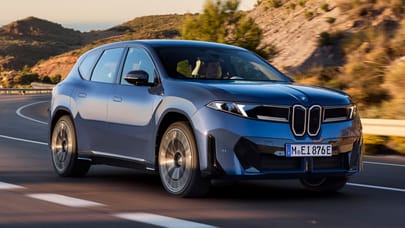

The big book of racing Driver Excuses has been opened at a new page. Jellyfish causes crash. Seriously. How hilarious is that? Well, not for the driver, who's nursing some light whiplash and the expression of a man who, presented with a convenient cliff, might well avail himself of its gravitational properties.
And it's safe to say that at this precise moment the rest of the team is failing to see the funny side, too. Nor is Top Gear rolling around clutching its sides. You see, this state of affairs could well be all our fault - Top Gear might just have scuppered a Land Speed Record. Time to creep stealthily away and duck behind a sand dune before anyone starts pointing fingers.
Words: Ollie Marriage
Pics: Jamie Lipman
This article originally appeared in the September 2011 issue of Top Gear magazine
Advertisement - Page continues below
Bluebird. Even a scant prowl through your memory banks should churn some land-speed familiarity from the name. In 1924, it appeared on a Sunbeam powered by an 18.3-litre 350bhp V12, a car that set the land speed record on this very beach in west Wales, driven by a certain Malcolm Campbell.
Now Malcolm's grandson Don Wales is at Pendine and aiming to give the family business a generational boost. The current holder of the steam-powered world record, this time he's using another fuel source to try to break a land speed record. This time, it's electricity.

You wouldn't think electricity mixes too well with salt water, or that sand is a particularly suitable surface for record attempts these days - the last world record set on Pendine's beach was 84 years ago. That must have been amazing to witness, as various chaps-in-goggles set off in pursuit of derring-do and 175mph, driving aero-engined monsters.
Today, Pendine will echo to the sounds of... well, mostly the battered and unsilenced Land Rovers driven by the marshals. Bluebird itself will barely emit a decibel as it aims for 150mph. That would be a new British land speed record, 13mph up on the current mark set here 11 years ago by Don Wales in this very car...
Advertisement - Page continues below
Beach and bloke may be the same, but the mechanics have changed. The battery packs are now nickel-cadmium not lead-acid, and instead of 135bhp and 53lb ft of torque, the two rear-wheel electric motors now generate a total of 402bhp and 664lb ft. Ultimately, Don wants to take Bluebird to Bonneville and push the electric LSR to over 500mph.
It's a bright Sunday morning, and many people in fluorescent tabards are hanging around the top of the slipway onto the beach. Some are carrying shovels. Others are in orange overalls adorned with hillclimb patches. Luxuriant facial hair is popular. And TG has a job. Fodding. This isn't a swear word. Foreign Object Damage is what happens if the car hits something during its run - driftwood, crab, big stone, small child, that sort of thing.

The reason for Fodder-in-Chief's urgency is clear when we return to base. Many, many members of the public have gathered, they are consuming much ice cream and they want to see Bluebird go fast. Right Now. The trouble is, record-breaking is a largely methodical, laborious, scientific process, and that jars with the public's demand for instant gratification.

Don Wales isn't driving; his place in the cockpit occupied by his 19-year-old son, Joe, aiming to add another generation to clan Campbell's record-breakers. Eventually, after much tinkering by engineering types, Bluebird moves anonymously, silently off down the beach. Many people miss it.
This is a shame, because it won't come back. We wait. Garbled radio messages suggest all is not well. That suspension damage has happened. At this point, TG panics about its responsibility for the unfodded area and considers sneaking off with the grumbling public, who are mainly upset because the crash has happened out of sight.

Much later again, Bluebird is trailered back. The carbon-fibre body is lifted off, and the damage is revealed. The front off-side wheel is held in place only by the suspension topmount - both steering arm and lower wishbone have been shattered. I grab Joe (he of the cliffdive-onto-rocks demeanour). "Yeah, the car got airborne for a bit at about 100mph, and when it landed, it just dug in and hit one of the potholes."
Yes, potholes on a beach.
Advertisement - Page continues below
They're deep indentations left by jellyfish as the tide goes out. Joe had been so far off course, halfway down to the sea in fact, that he missed the entry to the timing gate, in fact never went near the fodded area. I can see why visibility is tricky on the featureless beach and why it was a mistake not to mark the racing line in biodegradable paint, but that's got to be embarrassing. Relief, however, floods over TG.
Team Bluebird attempts to look on the bright side. The guys conduct TV interviews and photo opportunities, even release charity balloons, but it's like letting a party popper off at a funeral. On this occasion, Bluebird has been a Great British failure. TG was proud to be part of it.
Trending this week
- Car Review
BMW 1 Series
- Top Gear's Top 9
Nine dreadful bits of 'homeware' made by carmakers







